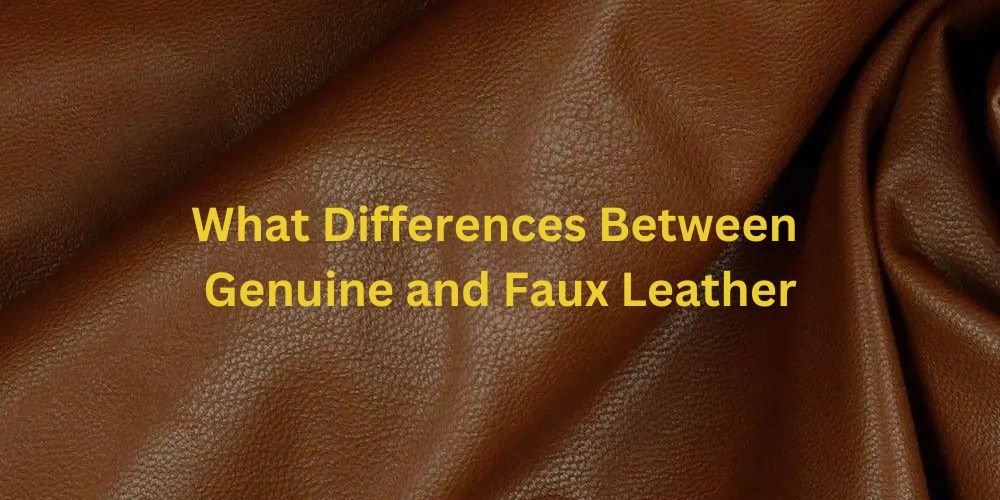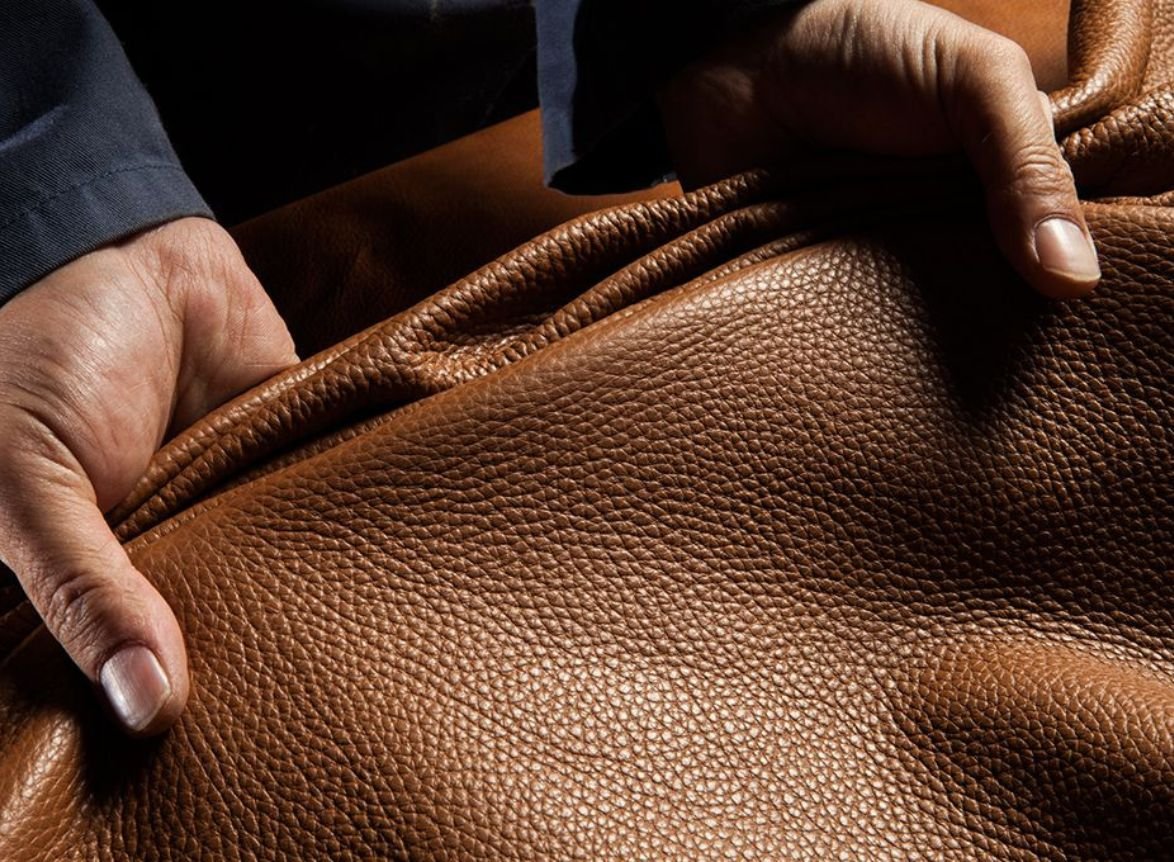For many years, leather has stood for elegance, toughness, and classic design. Deciding between authentic and fake leather indicates that you value morality and style. Hi there! These days, the decision between authentic and fake leather is becoming increasingly important. It’s wonderful to see people choosing their consumer habits carefully. You do realize that the key is striking a balance between sustainability and style? Continue making well-considered decisions! It’s wonderful to have options! Customers should educate themselves about leather goods to make wise decisions. We explore the distinctions between real and fake leather in this extensive tutorial to give you the confidence to explore the world of leather.
UNDERSTANDING GENUINE LEATHER
COMPOSITION AND SOURCE:
Real leather comes from the meat industry, which employs hides that would have otherwise been thrown away. It is created from the skin of animals. Discover the world of premium leather, a sustainable option with a distinctive origin tale. Materials that may be thrown away get value from this sustainable method. Genuine leather comes in three main varieties: full-grain, top-grain, and corrected-grain.
CHARACTERISTICS:
- Real leather preserves the pores, wrinkles, and scars left by the animal. Each piece is unusual and unique because of these flaws. Its distinct and genuine appearance is enhanced by these characteristics.
- Since genuine leather is permeable, air may flow through it. It is therefore comfortable to wear, particularly with clothing and accessories.
DURABILITY AND AGING:
- Real leather is renowned for being long-lasting and resilient. Its resilience to years of use and the deep patina it acquires with age add to its allure.
- Real leather matures beautifully, changing in tone and texture. People find it intriguing how leather takes on age; it’s as though the object acquires a personality of its own.

UNDERSTANDING FAUX LEATHER
COMPOSITION AND SOURCE:
Made from materials such as polyvinyl chloride (PVC) and polyurethane (PU), it provides a more environmentally friendly choice without sacrificing design. This is a fantastic approach to increase the accessibility and environmental friendliness of fashion. It is an artificial substitute that resembles genuine leather. This synthetic substitute is intended to resemble real leather in appearance.
CHARACTERISTICS:
- Since fake leather lacks the inherent flaws seen in real leather, it frequently has a more uniform appearance. The texture could seem uniform and shallow compared to real hides.
- It’s crucial to take into account both practical comfort and ethical shopping when selecting apparel and consumer goods. Your observations clarify the complex relationship between these choices. Just something to consider for your own convenience!Just something to consider for your own convenience!
DURABILITY AND AGING:
- While imitation leather has improved, real leather often has a longer lifespan. If you’re considering how long your belongings will last, this information is helpful. With time, it can begin to peel, crack, or exhibit symptoms of wear.
- Unlike real leather, faux-ake leather does not acquire a patina. Alternatively, imitation leather may not age as well and may eventually lose part of its attractiveness. Just something to keep in mind if you like to keep things fashionable!

DEBUNKING COMMON MYTHS
MYTH: ALL GENUINE LEATHER IS EQUAL:
As it happens, not every authentic leather is made equally. The best quality leather is full-grain leather, which comes from the outermost layer of the hide and keeps its original grain and qualities. Although authentic, top-grain and corrected-grain leathers go through processes that can compromise their longevity and aesthetic appeal.
MYTH: FAUX LEATHER IS ALWAYS INFERIOR:
With advancements in technology, faux leather has become increasingly similar to the real thing and is now hard to tell apart. It’s a fantastic option for ethical fashion and consumerism, providing a chic and cruelty-free substitute.
SUSTAINABILITY CONSIDERATIONS
GENUINE LEATHER’S ENVIRONMENTAL IMPACT:
Genuine leather requires consideration for the environment in addition to the use of animals for food. There’s more to this story than just ethics. Deforestation, water pollution, and greenhouse gas emissions have all been connected to the leather sector. Therefore, it’s crucial to consider the environmental impact while selecting leather items.
FAUX LEATHER’S ENVIRONMENTAL IMPACT:
The process of creating fake leather, which mostly involves petrochemicals, raises environmental issues because it uses resources that would otherwise decompose naturally. Eco-friendly materials such as plant-based and recycled alternatives are becoming more and more prevalent. This gives those who are concerned about the environment more options.
ETHICAL DILEMMAS
ANIMAL WELFARE IN GENUINE LEATHER:
Using animal hides that could otherwise be thrown away is a common practice for producing leather. We are prompted to consider the treatment of animals in the meat business by this procedure. It serves as a reminder to think about the welfare of the animals used in that sector. Conscientious customers must endorse leather that is sourced ethically and is free from cruelty.
SYNTHETIC LEATHER AND ENVIRONMENTAL RESPONSIBILITY:
Those who care about animal welfare can make ethical decisions by selecting imitation leather. However, we must take the environment’s impact of synthetic materials into account. It prompts us to consider the environmental impact of our decisions and how responsibly we are consuming. Selecting alternatives made of plants or recycled materials helps make the decision more sustainable.
BALANCING FASHION AND FUNCTION
FASHION-FORWARD WITH GENUINE LEATHER:
Genuine leather lovers like how it develops character with age, much like a good wine. The vivid colors and distinctive patterns of genuine leather give it an incredibly appealing appearance. It’s the preferred option for anyone looking for a smooth transition between style and quality. It’s the best option for those who wish to seamlessly combine quality and flair.
FAUX LEATHER’S VERSATILE APPEAL:
Versatile, fashion-forward people are catered to by faux leather. Trend-conscious customers have more options thanks to its uniform appearance and versatility in terms of color and texture without requiring them to commit to a permanent, changing aesthetic.
THE VERDICT: INFORMED DECISION-MAKING
There’s no universal solution in the ongoing argument between real and faux leather. The decision is based on a trifecta of practical requirements, ethical concerns, and personal preferences. Some people find it impossible to resist the timeless beauty and distinctive aging process of genuine leather. Some choose imitation leather because of its accessibility, cruelty-free status, and growing range of sustainable solutions.
It is our responsibility as consumers to make decisions informed by information and founded on our values. Knowing the difference between genuine and synthetic leather enables us to encourage moral behavior and make informed decisions. Choosing leather goods demonstrates our concern for ethical fashion and shopping, whether we prefer the inventiveness of imitation leather or the authenticity of real leather.

MAKING INFORMED CHOICES
PRICE POINT:
Since genuine leather requires a laborious and careful tanning process, genuine leather products are usually more expensive. Because it is a mass-produced material, faux leather is frequently less expensive.
SUSTAINABILITY:
Since genuine leather sourced responsibly uses animal industry byproducts, it can be considered sustainable. Even if faux leather is produced without using cruelty, petrochemicals may be used in the process.
CARE AND MAINTENANCE:
To keep its suppleness, genuine leather needs to be well cared for, sometimes conditioning it as well. While faux leather is typically easier to clean, real leather may be more resilient to severe environments.
CONCLUSION
The decision between real and imitation leather ultimately comes down to personal taste, morality, and the intended use of the item. While imitation leather is more affordable and a cruelty-free substitute, genuine leather boasts authenticity, toughness, and a distinctive aging process. Knowing these distinctions as a customer gives you the power to buy leather that complements your ideals and way of life. It’s crucial to choose between the flexibility of imitation leather and the timeless appeal of genuine leather. Understanding the distinctions makes it easier to choose leather products that complement your ethical principles and sense of style.






Leave a comment
Your email address will not be published. Required fields are marked *